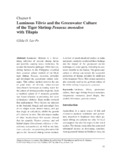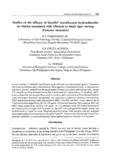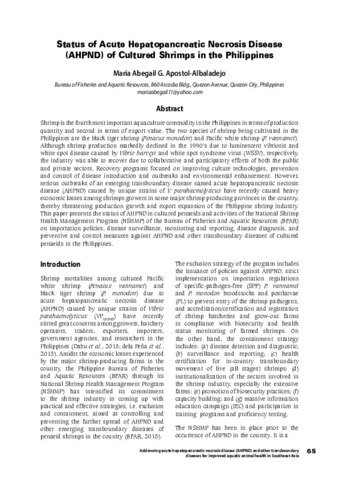Luminous Vibrio and the greenwater culture of the tiger shrimp Penaeus monodon with tilapia
Share
Abstract
Luminous vibriosis is a devastating infection of penaeid shrimp larvae and juveniles causing heavy mortalities. To counter the bacterial pathogen, Vibrio harveyi, shrimp farmers in the Philippines modified their growout culture method of the black tiger shrimp, Penaeus monodon, juveniles and developed the greenwater culture technique. This culture method involves the use of pond water of all-male, saline-tolerant Oreochromis hornorum as rearing water for the culture of shrimp juveniles in ponds. Such a modified culture of P. monodon juveniles was found effective in preventing the onset of luminous vibriosis. Basic studies revealed that antiluminous Vibrio factors are inherent in the bacterial, fungal, and microalgal flora of the tilapia water, dermal mucus, and gut that singly or collectively inhibit the growth of V. harveyi, in vitro. The skin mucus studies of other brackishwater fish species showed that the siganids, Siganus guttatus, and red hybrid tilapia (Oreochromis niloticus × Oreochromis mossambicus), as well as sea bass, Lates calcarifer, are promising alternative fish species for this novel shrimp culture method. A review of pond-simulated studies in tanks and ponds, similarly, confirmed these findings and the impact of the greenwater culture technique on water quality, including its economic benefits to the farmer. The greenwater culture of shrimp can sustain the successful production of shrimp juveniles by inhibition of the luminous Vibrio. This culture method is also currently used in the growout culture of the white shrimp, Litopenaeus vannamei.
Suggested Citation
Lio-Po, G. D. (2017). Luminous Vibrio and the greenwater culture of the tiger shrimp Penaeus monodon with tilapia. In P. W. Perschbacher & R. R. Stickney (Eds.), Tilapia in Intensive Co-culture (pp. 81–93). Chichester, UK: John Wiley & Sons, Ltd.
Subject
Taxonomic term
Collections
Related items
Showing items related by title, author, creator and subject.
-
Studies on the efficacy of Sarafin® (sarafloxacin hydrochloride) on vibrios associated with vibriosis in black tiger shrimp (Penaeus monodon)
Pakingking, Rolando V., Jr.; Lacierda, Erlinda; Torres, James L. (Fish Health Section, Asian Fisheries Society, 2002)In vitro activity of Sarafin® (sarafloxacin hydrochloride) was determined against 7 luminous Vibrio harveyi isolates and 3 non-luminous Vibrio species (V. parahaemolyticus, V. alginolyticus and Vibrio species) isolated ... -
Current status of shrimp farming and diseases in Cambodia
Lang, Ouch; Sothea, Mey (Aquaculture Department, Southeast Asian Fisheries Development Center, 2016)The farming of penaeid shrimps in Cambodia began in 1989 and has significantly expanded since 1991. Shrimp cultivation has been carried out in the four coastal provinces, i.e. Kampot, Kep, Preah Sihanouk Ville, and Koh ... -
Status of acute hepatopancreatic necrosis disease (AHPND) of cultured shrimps in the Philippines
Apostol-Albaladejo, Maria Abegail G. (Aquaculture Department, Southeast Asian Fisheries Development Center, 2016)Shrimp is the fourth most important aquaculture commodity in the Philippines in terms of production quantity and second in terms of export value. The two species of shrimp being cultivated in the Philippines are the black ...






